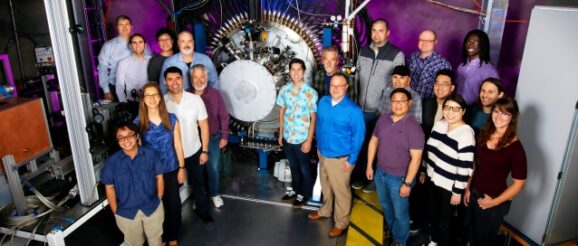Radiography innovation shows new promise with experimental dense plasma focus milestone

In early May, the Lawrence Livermore National Laboratory Megajoule Neutron Imaging Radiography Experiment (MJOLNIR) team’s dense plasma focus (DPF) achieved greater than 1012 neutrons in a single deuterium gas shot — an achievement that expands the possibilities for understanding lightning-fast phenomena that can’t be seen with the naked eye.
As an alternative to X-ray visualization, neutron-source radiography can capture images of more lightweight elements than a traditional X-ray machine can, which has far-reaching implications for stockpile stewardship and national security.
As a prototype neutron source for radiography, the MJOLNIR DPF runs powerful electrical currents through a gas, which causes it to ionize into a plasma before generating a powerful magnetic field that compresses or “pinches” the plasma. This pinching generates an extremely bright but brief (about 100 billionths of a second, or 100 nanoseconds) flash that allows for rapid-fire still-frame photography.
The recent shot’s yield represents a 30-fold increase since MJOLNIR was first turned on in 2018, and the team’s goal is to meet radiography requirements that require even further improvement, so that the DPF produces 1013 neutrons per shot. These radiography requirements would allow for a dynamic neutron radiography system in which clear images with less statistical noise are generated.
To this end, upcoming MJOLNIR experiments will include an effort to lower the neutron spot size — the location where the neutrons originate — because larger spot sizes contribute to blurrier images. Using a re-entrant cathode in concert with noble gas dopants (elements that alter the plasma dynamics) helps reduce the pinch and spot sizes by allowing the plasma to radiate some of its energy away.
If successful, the lowered spot size could make neutron radiography useful during Neutron Diagnosed Subcritical Experiments (NDSE) that aim to measure plutonium reactivity and thus validate various models that assess stockpile safety.
Currently, MJOLNIR’s neutron generator is housed in a large pit previously used in the Nova laser experiment that preceded the construction of LLNL’s National Ignition Facility, and its capacitive energy storage (on the order of 2 megajoules) is another level below that. Recently, the team began operating at higher stored energy levels of 1.3 MJ compared to their prior record of 1.0 MJ. Eventually, the team plans to take advantage of all 2 MJ of energy capacity.
Another milestone for the team came with the successful completion of 500 shots on the existing hardware — the longest that they have gone without insulator breakage.
Breakage can occur when the high voltage finds a path along which to ionize gas, and ultimately to conduct current somewhere that current is not supposed to flow.
“Previously we had a segmented insulator, and it usually failed at the break point between the two pieces,” explains MJOLNIR team lead Andréa Schmidt. “A significant redesign effort that took place in 2021 and 2022 produced a solid insulator that attaches to the back of the DPF differently, making it a much longer and more difficult path for current to flow along if it decided to flow where it wasn’t supposed to.”
After demonstrating that radiography requirements can be met, the team hopes to deploy these systems to various sites where visualization into the inner workings of an apparatus would be useful.
– Aimee Fountain
